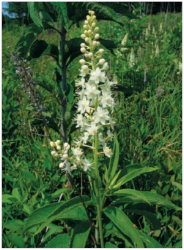New Species Descriptions
SGI staff and research associates are engaged in a variety of different research projects focused on grassland biodiversity and ecology.
According to data compiled by SGI Grassland Advisory Board Chair, Dr. Alan Weakley, since 1960 there have been hundreds of new species discovered in the southeastern U.S. A large percentage of these represent grassland species. Currently, botanists are aware of at least 130 new plant species in the Southeast that don't yet have a name. Of this number, at least 99 are grassland species. At the rate of current grassland loss, it is quite possible that many of these species could go extinct before they are even named to science.
New species aren't just being discovered in plants. A variety of new animal species found in grasslands have been described in recent years, including grasshoppers, moths, burrowing crayfish. Word has it that there may still be an undescribed mammal or two from Southern grasslands.
Tennessee Featherbells
In December 2017, Dr Alan Weakley (Director of the University of North Carolina Herbarium and Chairman of SGI's Scientific Advisory Committee) and Bruce Sorrie collaborated to name the Tennessee Featherbells (Stenanthium tennesseense), a rare new species known from just five counties in south-central Tennessee and nowhere else in the world.
Pelton's rose gentian
This species was discovered by SGI Director of Science, Theo Witsell. It is known from just two small rocky grasslands in Saline Co., Arkansas and nowhere else in the world.
21 New Species of grasshoppers
Dr. JoVonn Hill, entomologist at Mississippi State University's Mississippi Entomological Museum recently named 21 new species of grasshoppers. All were discovered in remnant grasslands scattered across the South.
a new moth
Dr. Richard Brown of the Mississippi Entomological Museum at Mississippi State University is one of the leading experts on moths of North America. In 2005, he and a Swiss colleague described Neodactria oktibbeha, a globally rare moth known from a single prairie near Starkville, Mississippi and nowhere else worldwide.




